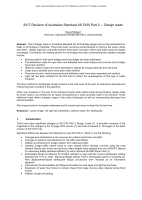Bridges

- Publication no: ABC2017-133-17
- Published: 26 April 2017
- PDF (free) Download
Part 2 Design loads of Australian Standard AS 5100 Bridge design sets out the parameters for loads on all bridges in Australia. There have been numerous enhancements to improve the scope, clarity and intent. Design loads for road traffic barriers have been increased. Other road traffic loads are largely unchanged. Conversely, the loading section for rail bridges has been comprehensively updated changes include:
- Braking loads for both short bridges and long bridges has been addressed.
- The distribution loads for open deck and ballasted deck steel bridges and concrete deck bridges have been clarified.
- Different collision loads have been specified for objects at varying distances from the track.
- Loads due to derailed trains have been better defined.
- Protection of piers, vertical abutments and deflection walls have been expanded and clarified.
- Light rail has been included for the first time to reflect the re-emergence of this type of public transport.
The force method for earthquake design remains in the main body of the part. An alternative displacement method has been included in the appendix.
Other new inclusions in this part of the standard include urban debris loads during flooding, design loads for errant road or rail vehicles for air space developments in close proximity road or rail corridors. These additional loads reflect changed usage in the urban landscape as well as incorporating learnings from natural disasters.
Ship impact loads for navigable waterways and fire loads have been included for the first time.
